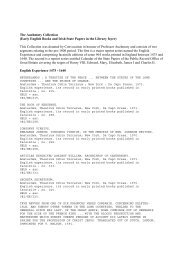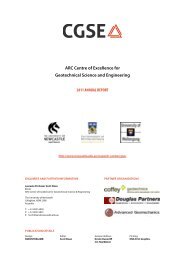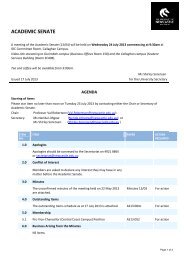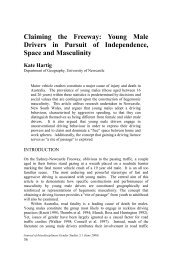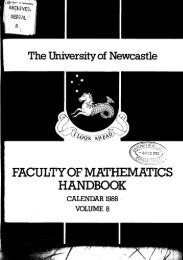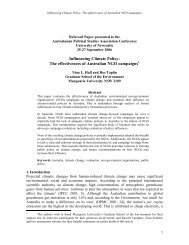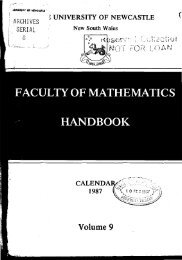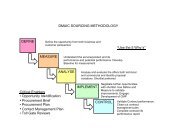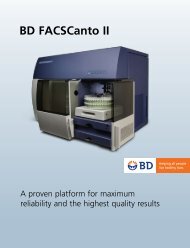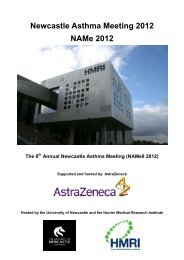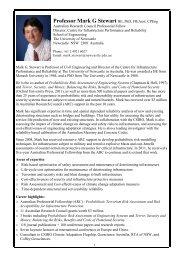n - University of Newcastle
n - University of Newcastle
n - University of Newcastle
Create successful ePaper yourself
Turn your PDF publications into a flip-book with our unique Google optimized e-Paper software.
xxvi IPI-TBODUCTION.<br />
ha~e noticed in the course <strong>of</strong> my reading, but I believe there are<br />
many other words in these islands which are <strong>of</strong> the same origin<br />
as our Australian word wakul." I pray you to remember that,<br />
with the exception <strong>of</strong> Samoa and New Zealand, these words all<br />
come from Papuan regions and afford indirect evidence that our<br />
Australians are allied to the Papuans.<br />
As to the Maori and Samoan congeners that I have quoted, it<br />
is commonly alleged that these races are &Ialayo-Polynesians, on<br />
the theory that their languages are <strong>of</strong> Malay origin -f-; but let us<br />
look at this theory in the hght <strong>of</strong> our present inquiry. It is<br />
said that the Polpnesims are Malays. Well, let us see. If the<br />
Samoans are Ifalays, then the Duke <strong>of</strong> Pork Islanders are<br />
Illalays ; for the n-ord mua, l-ihich is essential to the Samoan<br />
language, is the same word as the Tulriok muka ; therefore the<br />
Papuans <strong>of</strong> that island also are Malays ! But the corresponding<br />
Malay mord is miila, 'in front,' ' foremost,' 'at first,' and it is<br />
certain that muka can never be formed from mu1 a ; for, while<br />
?c may become 1, the letter I, when once established in a word,<br />
cannot revert to k. Thus the Malay language might be said to<br />
have come from the Duke <strong>of</strong> York Island, as least so far as the<br />
evidence <strong>of</strong> this word goes ! But I acknowledge that they may<br />
both be taken from one conlmon source, and this, I believe, is the<br />
true solution <strong>of</strong> the question. Where shall we find that common<br />
source ? The root-form <strong>of</strong> mula, muka, mua, and <strong>of</strong> dl the<br />
others, is ma, mu, and if me can find that root, it mill be easy to<br />
understand how all these words have been formed independently<br />
from that original root ; and it will then he unnecessary to say<br />
that the Bamoau language is <strong>of</strong> Dlnlay origin, or that the<br />
Papuans <strong>of</strong> the New Britain isles are usiug a lSIalay language. I<br />
now take you to southern India, to a group <strong>of</strong> languages called<br />
the Dravidian, occupying the mouiitains <strong>of</strong> the Dekkan, and the<br />
coasts both to the east and the west <strong>of</strong> that. Some <strong>of</strong> these<br />
Dravidian tribes are considered by the best authorities to be<br />
certainly negroid, and, in England, Pr<strong>of</strong>. Flower, from an examination<br />
<strong>of</strong> their crania, has classed them as kinsmen <strong>of</strong> the<br />
Australians. One <strong>of</strong> the most cultivated languages <strong>of</strong> the group<br />
is the Tamil, and the Tanlilians are known to have class-marriage<br />
. laws similar to those in Fiji and Australia. Now for ' first ' the<br />
Tamil says mudal, and this mudal is a verbal noun meaning 'a<br />
beginning,' ' priority ' in time or place. The root is mu, and dal<br />
is a formative syllable. Themu is, without doubt, our Australian<br />
* These aud all other words from the New Britain and Duke <strong>of</strong> Pork<br />
Islands I quote from mziluscript dictionaries <strong>of</strong> these languages, prepared<br />
by the missionaries there.<br />
t The name and authority <strong>of</strong> K. Wilhelm von Humboldt first gave this<br />
theory a standing; but we have now much fuller materials on wluch to<br />
form an independent judgment.<br />
~sraouccr~os. xxvii<br />
root ma, mo, mu. The late Bishop Cald~ell says*-"Xudai is<br />
connected with the Tamil postposition mnn, ' before'; mudal is<br />
used as the root <strong>of</strong> a new .verb ' to begin.' Mu erideiltly signifies<br />
'priority,' and may be the same as the Tamil mu, 'to be old,'<br />
mudu, ' antiqxy: " I think there is a better derivation than<br />
that. The San nt milla means ' origin, cause, commeucement,'<br />
and is the same word as the Malay mula already referred to,<br />
and both <strong>of</strong>.these I take from the Sanskrit root-word bhii, ' to<br />
begin to be, to become, to be,' with which is connected the Latin<br />
fore (fuere), ' to be about to be,' f ui, kc. From bhil come<br />
such Sanskrit words as bhava, ' birth, origin,' bh &van a, ' cnusing<br />
to be,' b huvan y n, ' a master or lord ' (r$ pira n, kc.), and<br />
many other words in the Aryan languages. At all events,<br />
m akul and these other Australian mords for ' one ' are assuredly<br />
from the same root as the Dravidian mu-dal, ' first,' ' a begin-<br />
. I, for one, cannot believe that words so much alike both in<br />
root and meaning should have sprung up by accident over so vast<br />
an area as India, Malaya, New Guinea, Fiji, Samoa, and baclr<br />
again to the New Bebrides and Australia. The only rational<br />
explanation seems to me to be that these races were all at one<br />
time part <strong>of</strong> a common stoclr, that in their dispersion they carried<br />
with them the root-words <strong>of</strong> the parent languages, and that in<br />
their new habitations they dressed out these root-n-ords with<br />
prefixes and affixes by a process <strong>of</strong> development, just as circumstances<br />
required.<br />
Results. -The root in its simplest form is ha, 'to begin to be,'<br />
' to begin '; other forms are 6 0, 13 u, B i ; nz a, 1780, mzc; ja, f~, vu;<br />
wa. The nearest approach to the Australian zun kt&/, ' one,' is<br />
the Ebcdan 6 o kol, ' one,' and the Tukiok or nkal-a, ' for the<br />
first tinle,' but many other cognate words are foulid all over the<br />
South Seas in the sense <strong>of</strong> 'first,' 'begin.' The Tasma~liitll<br />
otaro-wa, 'one,' is the same as the Tukiok ~naka, ' for the first<br />
time,' and nza?-n, 109 ; and in New South Wales, nznra-gai<br />
means ' first ' in the Nudgee dialect.<br />
2. The ,VunzeraZ Tzco.<br />
AInlost the only other dustralian~lumeral is b ul a, ' tn 0.' It is<br />
true that several tribes have a distinct mord for ' three,' and a few<br />
have a mord for ' five ' taken from the word ' hand,' but in most<br />
parts <strong>of</strong> Australia the number 'three ' is expressed by ' tn-o-one,'<br />
four' by ' two-two,' 'five' by ' two-two-one' and so on. But the<br />
wore bula is universal ; vith various changes <strong>of</strong> termination, it<br />
exists from Tasmania in the extreme south, right on to the Gulf<br />
*All my knowledge <strong>of</strong> the Dravidian race and language comes from Dr.<br />
Caldwell's " Colnparative Dictionary <strong>of</strong> the Dravidian or South Indian<br />
Family <strong>of</strong> Languages ; second eciition ; London : Trubner and Co., 1875." In<br />
this Introduction, I quote from the notes which I made vhen I read the<br />
book some years ago, and now I cannot always tell whether I ain cluoting<br />
his words or only my own statement <strong>of</strong> them.



